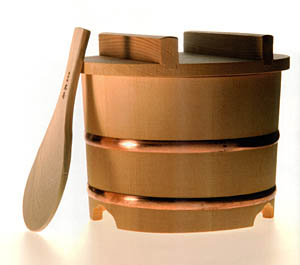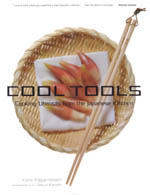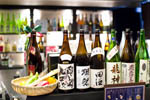Rice tub

This elegant steamed-rice tub, or ohitsu, is made of sawara cypress, and is used to keep rice warm at the table. The sawara comes from the forests of Kiso in Nagano Prefecture, and is rated so highly that it is protected by the government. In fact, the shrines at the sacred Ise complex, on eof Japan's most revered sites, are ritually rebuilt in twenty-year cycles, using Kisa sawara.
Traditionally, rice would be transferred from a cooker to an ohitsu and placed at the edge of a low table on the tatami, where the housewife would sit. It was her job to dish the rice into family members' bowls and replenish them.
Today, as busy schedules mean that families rarely share their mealtimes, we often see family members serving themselves directly from the rice cooker. It's more likely that ohitsu only make an appearance on special occasions or when entertaining guests. I've even seen one creative hostess using ohitsu small enough to hold only one or two portions of rice, for individual place settings. While most ohitsu today are made by machine, this vessel was made entirely by hand using a round plane. It took more than eight hours to finish.
Makisu mat

Makisu mats are essential in the making of makizushi sushi rolls, and tend to be the same size - ten inches square. It may look like a snap in the hands of a seasoned cook, but making sushi rolls is far from easy. The nori seaweed is laid on the mat, then coated with vinegared sushi rice and filling before being rolled. But without years of practice, spreading the rice evenly and rolling it in a smooth, even motion to create an aesthetically pleasing spiral of filling can be maddeningly frustrating.
Makisu have long been used to shape other items as well, such as omelets, or to squeeze off excess liquid from food materials. One friend, for example, uses hers to strain off the last traces of water from spinach while shaping it for ohitashi. For this dish, spinach is cooked whole, with the ends dipped in the boiling water first before the leaves are plunged. While the spinach is still firm, it is removed and squeezed into a tight roll before slicing.
Rice tubs are available at Kiya in Tokyo: www.kiya-hamono.co.jp.
Makisu mats are available at Aritsugu in Kyoto: www.aritsugu.com.
Source Notes

Reprinted with permission from the book:
Cool Tools: Cooking Utensils from the Japanese Kitchen
Kodansha International
Japanese cuisine is flourishing among the food-conscious all over the world - as are the recipe-laden cookbooks. Now, this book goes inside the kitchen, but this time into the cupboards and drawers, onto stovetops and wall hangers where all sorts of utensils, pots and pans are stored. Here are the items that are manipulated in the hands of the famous in their awe-inspiring kitchens - and the not-so-famous in their homes.
As with so many Japanese creations, the utensils that stock a Japanese kitchen are both functional and artistic. And the pieces that are the focus of this book are treated as both works of art and items of practical interest. This is a book for the professional chef and the curious amateur, a perfect addition to the well-stocked cookbook library.
ISBN4-7700-3016-9
Y2800
- Order this book from amazon.com
- Order this book from amazon.co.jp (in Japan)
- Find this book at your local English-language bookstore in Japan
- Or use the ISBN to order from your local bookstore.
More articles
- © Copyright Lobster Enterprises
- Privacy
- Bento.com top
- © Copyright Lobster Enterprises
- Privacy
- Bento.com top
- © Copyright Lobster Enterprises
- Privacy
- Bento.com top








